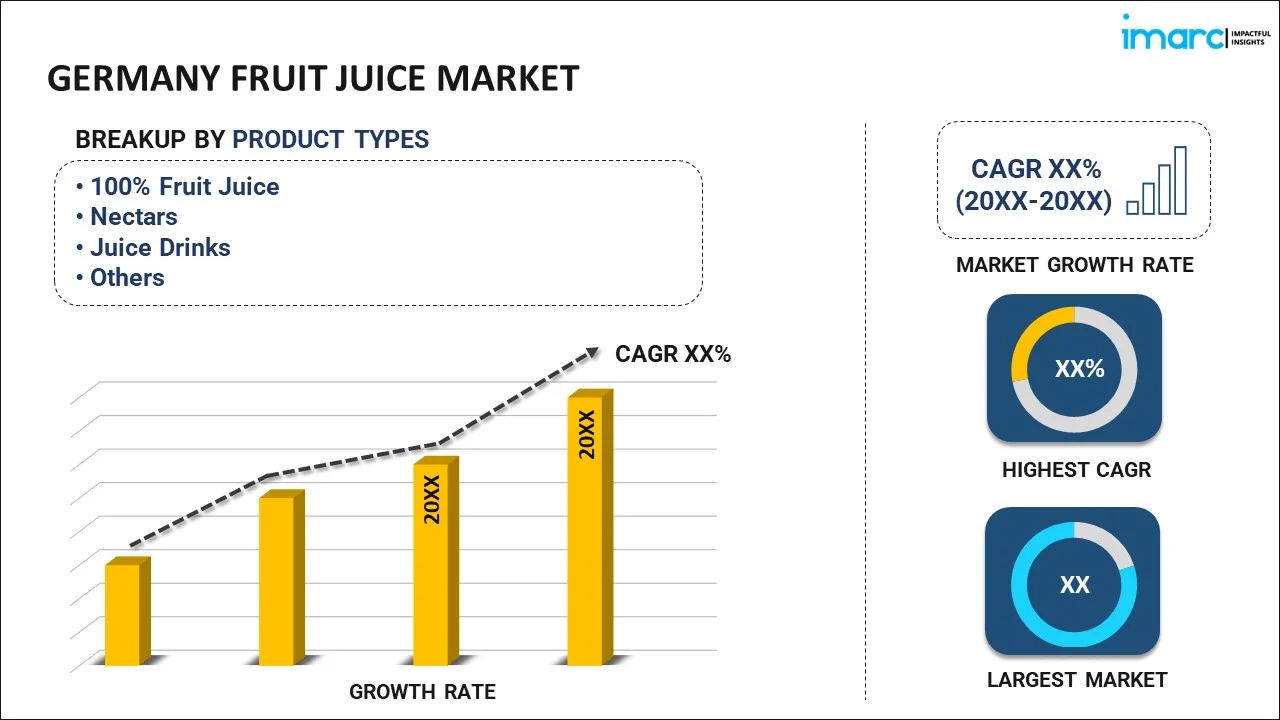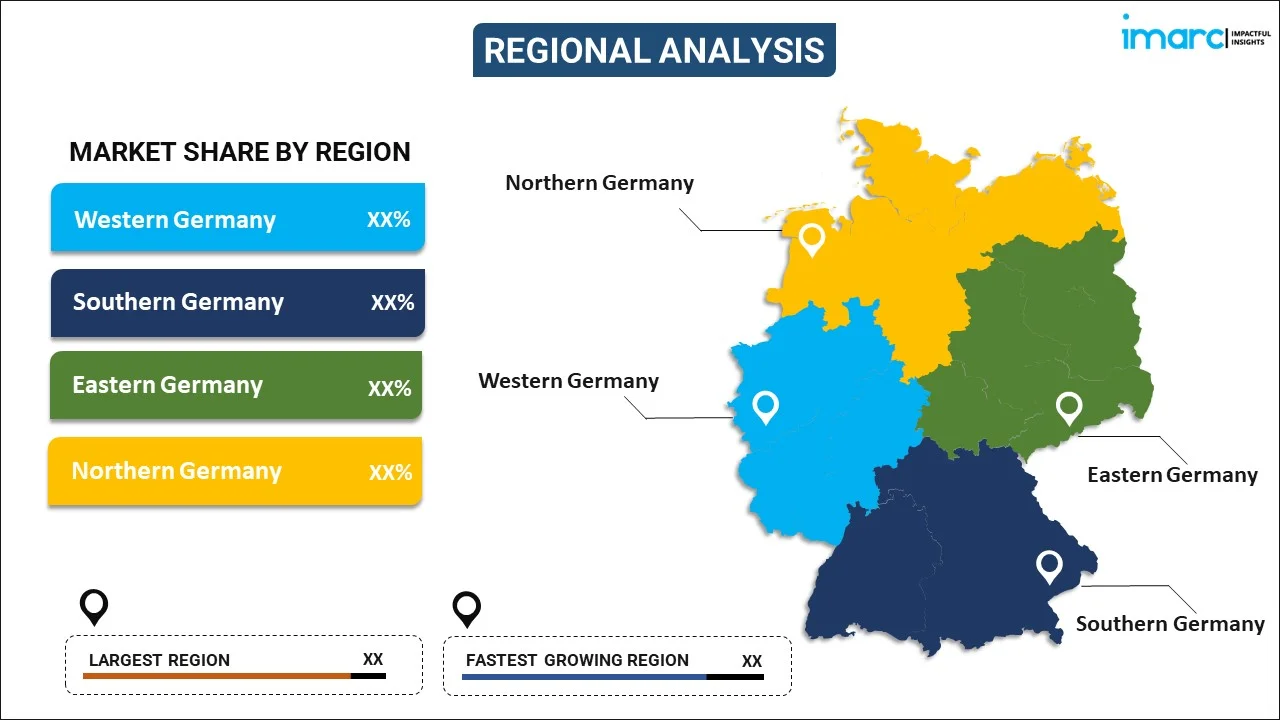
Germany Fruit Juice Market Report by Product Type (100% Fruit Juice, Nectars, Juice Drinks, Concentrates, Powdered Juice, and Others), Flavor (Orange, Apple, Mango, Mixed Fruit, and Others), Distribution Channel (Supermarkets and Hypermarkets, Convenience Stores, Specialty Food Stores, Online Retail, and Others), and Region 2025-2033
Germany Fruit Juice Market Overview:
The Germany fruit juice market size reached USD 7.2 Billion in 2024. Looking forward, IMARC Group expects the market to reach USD 10.2 Billion by 2033, exhibiting a growth rate (CAGR) of 3.98% during 2025-2033. The market is driven by the thriving food and beverage (F&B) industry, innovations in product, premiumization, and expansion of e-commerce platforms.
|
Report Attribute
|
Key Statistics
|
|---|---|
|
Base Year
|
2024
|
|
Forecast Years
|
2025-2033
|
|
Historical Years
|
2019-2024
|
|
Market Size in 2024
|
USD 7.2 Billion |
|
Market Forecast in 2033
|
USD 10.2 Billion |
| Market Growth Rate 2025-2033 | 3.98% |
Germany Fruit Juice Market Trends:
Thriving Food and Beverage (F&B) Industry
According to the Germany Trade and Invest report of 2023, Germany’s food and beverage industry is the fourth-largest industry sector in Germany, generating production value of EUR 185.3 billion in 2020. Germany has a mature F&B market supported by sound structures of supply chain management, distribution networks and transportation systems. These structures enhance the acquisition of raw materials, manufacturing techniques, and delivery of fruit juices, which is supporting the market expansion. Besides this, the consumer base in the F&B industry of Germany is also highly developed, demanding quality, taste, and healthy food products. As consumers are becoming health-conscious and seeking natural and nutritious beverage options, the demand for fruit juices is rising. The thriving F&B industry adapts to these shifts in demand by providing various fruit juices. Apart from this, food and beverage (F&B) industry of Germany is recognized for its strength in new product development. Companies are continuously investing in research and development (R&D) activities to create new and innovative fruit juice formulations, flavors, and packaging formats that resonate with consumers.
Expansion of E-Commerce Platforms
According to the International Trade Administration report of 2023, Germany e-commerce penetration reached 80% in 2022. E-commerce platforms often offer a broader selection of fruit juice products compared to brick-and-mortar stores. Consumers have access to a diverse range of flavors, brands, packaging sizes, and variants, enabling them to discover new products and find options that suit their preferences. Furthermore, e-commerce platforms give the consumers a variety of options for fruit juice products from different brands or manufacturers in the market. This has been attributed by the fact that through the help of internet facilities, consumers can access and buy fruit juices, regardless of their location, thereby contributing to the market growth.
With this in mind, e-commerce platforms are able to use data analytics and algorithms to alter the purchasing process for individuals. E-commerce platforms can highlight fruit juices with targeted recommendations and personalized promotions that correspond to individual needs and purchasing behavior of an individual to generate sales and buyers' engagement. Through e-commerce, fruit juice manufacturers can sell their products directly to the consumer leaving out the retail middlemen. This way, key players can influence and determine the price at which the products are sold.
Germany Fruit Juice Market News:
- February 24, 2023: Coca-Cola Europacific Partners invests in refillable bottling in Germany. They have decided to strengthen its reusable packaging capabilities with an investment of more than EUR40m.
- May 21, 2024: Kraft Heinz, the maker of Capri Sun launched new multi-serve format with 32 pouches’ worth of classic fruit punch flavor. They made this change to bottles because of consumer demand were for a larger product size.
Germany Fruit Juice Market Segmentation:
IMARC Group provides an analysis of the key trends in each segment of the market, along with forecasts at the country level for 2025-2033. Our report has categorized the market based on product type, flavor, and distribution channel.
Product Type Insights:

- 100% Fruit Juice
- Nectars
- Juice Drinks
- Concentrates
- Powdered Juice
- Others
The report has provided a detailed breakup and analysis of the market based on the product type. This includes 100% fruit juice, nectars, juice drinks, concentrates, powdered juice, and others.
Flavor Insights:
- Orange
- Apple
- Mango
- Mixed Fruit
- Others
A detailed breakup and analysis of the market based on the flavor have also been provided in the report. This includes orange, apple, mango, mixed fruit, and others.
Distribution Channel Insights:
- Supermarkets and Hypermarkets
- Convenience Stores
- Specialty Food Stores
- Online Retail
- Others
The report has provided a detailed breakup and analysis of the market based on the distribution channel. This includes supermarkets and hypermarkets, convenience stores, specialty food stores, online retail, and others.
Regional Insights:

- Western Germany
- Southern Germany
- Eastern Germany
- Northern Germany
The report has also provided a comprehensive analysis of all the major regional markets, which include Western Germany, Southern Germany, Eastern Germany, and Northern Germany.
Competitive Landscape:
The market research report has also provided a comprehensive analysis of the competitive landscape. Competitive analysis such as market structure, key player positioning, top winning strategies, competitive dashboard, and company evaluation quadrant has been covered in the report. Also, detailed profiles of all major companies have been provided.
Germany Fruit Juice Market Report Coverage:
| Report Features | Details |
|---|---|
| Base Year of the Analysis | 2024 |
| Historical Period | 2019-2024 |
| Forecast Period | 2025-2033 |
| Units | Billion USD |
| Scope of the Report | Exploration of Historical Trends and Market Outlook, Industry Catalysts and Challenges, Segment-Wise Historical and Future Market Assessment:
|
| Product Types Covered | 100% Fruit Juice, Nectars, Juice Drinks, Concentrates, Powdered Juice, Others |
| Flavors Covered | Orange, Apple, Mango, Mixed Fruit, Others |
| Distribution Channels Covered | Supermarkets and Hypermarkets, Convenience Stores, Specialty Food Stores, Online Retail, Others |
| Regions Covered | Western Germany, Southern Germany, Eastern Germany, Northern Germany |
| Customization Scope | 10% Free Customization |
| Post-Sale Analyst Support | 10-12 Weeks |
| Delivery Format | PDF and Excel through Email (We can also provide the editable version of the report in PPT/Word format on special request) |
Key Questions Answered in This Report:
- How has the Germany fruit juice market performed so far and how will it perform in the coming years?
- What has been the impact of COVID-19 on the Germany fruit juice market?
- What is the breakup of the Germany fruit juice market on the basis of product type?
- What is the breakup of the Germany fruit juice market on the basis of flavor?
- What is the breakup of the Germany fruit juice market on the basis of distribution channel?
- What are the various stages in the value chain of the Germany fruit juice market?
- What are the key driving factors and challenges in the Germany fruit juice?
- What is the structure of the Germany fruit juice market and who are the key players?
- What is the degree of competition in the Germany fruit juice market?
Key Benefits for Stakeholders:
- IMARC’s industry report offers a comprehensive quantitative analysis of various market segments, historical and current market trends, market forecasts, and dynamics of the Germany fruit juice market from 2019-2033.
- The research report provides the latest information on the market drivers, challenges, and opportunities in the Germany fruit juice market.
- Porter's five forces analysis assist stakeholders in assessing the impact of new entrants, competitive rivalry, supplier power, buyer power, and the threat of substitution. It helps stakeholders to analyze the level of competition within the Germany fruit juice industry and its attractiveness.
- Competitive landscape allows stakeholders to understand their competitive environment and provides an insight into the current positions of key players in the market.
Need more help?
- Speak to our experienced analysts for insights on the current market scenarios.
- Include additional segments and countries to customize the report as per your requirement.
- Gain an unparalleled competitive advantage in your domain by understanding how to utilize the report and positively impacting your operations and revenue.
- For further assistance, please connect with our analysts.
 Inquire Before Buying
Inquire Before Buying
 Speak to an Analyst
Speak to an Analyst
 Request Brochure
Request Brochure
 Request Customization
Request Customization




.webp)




.webp)












